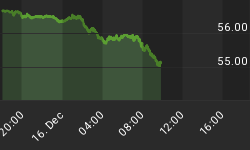This is an excerpt from a Resource Stock Guide Newsletter posted on March 16, 2008.
There was a lot of volatility in the markets last week as the Fed tried to prevent the financial sector from spinning out of control. The markets rebounded strongly in the beginning of the week only to be beaten down by the Bear Stearns news. Overall, the process of retesting the January lows continued.
The Bank Index ($BKX) continues to hold its January lows, while its cousin, the Broker/Dealer Index ($XBD), became the main spot for market troubles. $XBD plunged to new lows after Friday's shocking news of Bear Stearns' insolvency.
As everyone is aware, the Federal Reserve Bank of New York extended its greenback lifeline to JPMorgan Chase, which offered to help Bear. This bailout came only days after the Fed's announcement that it will establish a $200 billion Term Securities Lending Facility (TSLF). Before the TSLF went into effect (first auction is to be held on March 27), the Fed realized that much more had to be done. So the rules of the game were changed completely, allowing for an almost direct bailout (i.e. guarantee by the Fed) of not only the banks but of the brokers and dealers such as Bear.

We cannot help but see an opportunity for consolidation in the financial sector, where the stronger survivors will devour the weak. Certainly, brokers and dealers ate up a lot of toxic financial paper, doing this by using leverage as much as 30-1, which makes the situation exceptionally dangerous. As there is a complete lack of transparency in these derivative instruments, the market for them has almost disappeared, making the Fed the only buyer or guarantor of this paper. Using taxpayers' money, the Fed has now established a threshold or a floor for a financial institution that is too big to fail. And this floor is low; Bear's market cap was only $8 billion before the bailout announcement was made public. This was only the first undisguised step to prevent a financial system crash. Inflate or die!
Trading at around $30 per share, Bear Stearns is valued at only 1/3 of its book value as of a few months ago. Coincidentally or not, according to Barrons, the Bank of America's bid for Countrywide was also about 1/3 of the mortgage giant's book value. Many on Wall Street now hope that Bear will be bought out by JPMorgan at a similar or slightly lower discount (1/4 of book value based on latest news). If the buyout does happen, an acquisition model for other players will be established, with the Fed providing explicit or implicit guarantees.
The Fed and banking heavyweights are working through the weekend to engineer just another inflationary tactic which will help restore confidence in the financial sector. We are convinced that the Fed is also in discussions with major central banks around the world in an attempt to persuade them to cut rates.
If no new measures are announced, substantial selling pressure is likely. This could become a final washout before stocks begin a multi-month advance.
There are a number of reasons why we believe that the market is in a middle of a bottoming process and that a multi-month bear (Stearns) market rally is near:
-
Investor Sentiment has turned from bad to ugly. Amongst advisors, bears numbered 43% to only 31% bulls; AAII's bears vastly outnumbered bulls - 59% to 20%; Consensus Index showed that only 25% of traders remained bullish.
-
There are signs of fear on almost all types of debt instruments other than the federal government bonds. For example, yield spreads between government bonds and investment grade corporate bonds are now greater than they were in the darkest days of the bear market several years ago.

- The most vivid indicator of fear, the ratio between VIX index and T-bond yields (vixandmore.blogspot.com), is now at its highest level since the bottom of the 2001-2003 bear market. This shows that conditions on the options market are at a climactic level at the same time as large amounts of capital is fleeing away from riskier investments into the safety of government bonds that are paying a petty interest.

Next week is bound to be exciting. The market expects the Fed to cut its fed funds rate target by 75 basis points (to 2.25%) at Tuesday's FOMC meeting. Aside from the FOMC announcement, additional actions and statements on behalf of the Fed will be viewed as critical along with the earnings reports from several financial stocks (BSC, LEH, GS, MS) and a score of economic releases.
As the fiat financial system crisis continues to unfold, gold fundamentals are becoming stronger than at any point in recent history. More on precious metals and related stocks is available for subscribers.
















